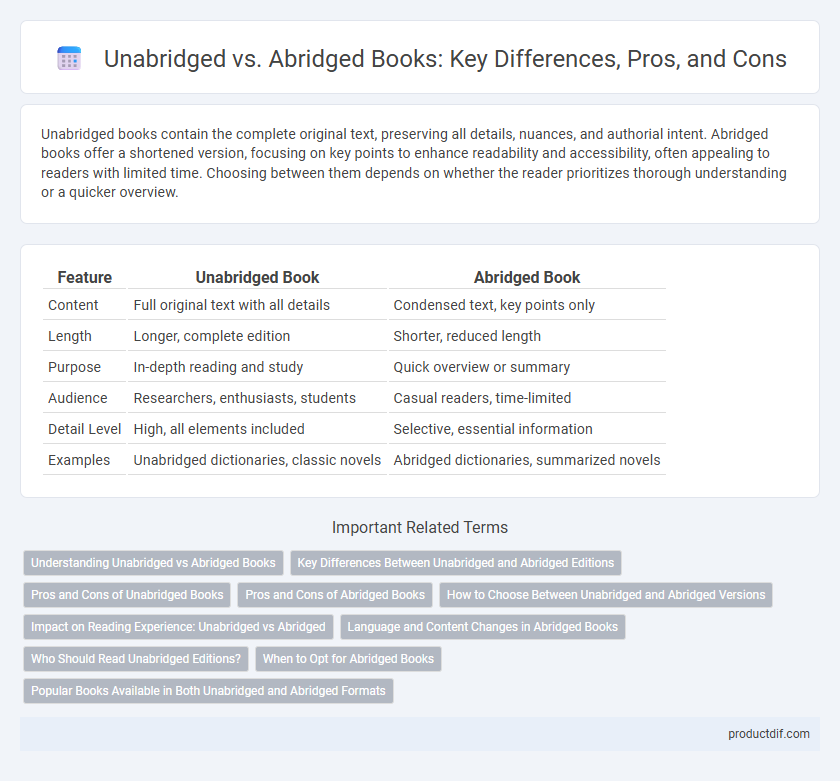Unabridged books contain the complete original text, preserving all details, nuances, and authorial intent. Abridged books offer a shortened version, focusing on key points to enhance readability and accessibility, often appealing to readers with limited time. Choosing between them depends on whether the reader prioritizes thorough understanding or a quicker overview.
Table of Comparison
| Feature | Unabridged Book | Abridged Book |
|---|---|---|
| Content | Full original text with all details | Condensed text, key points only |
| Length | Longer, complete edition | Shorter, reduced length |
| Purpose | In-depth reading and study | Quick overview or summary |
| Audience | Researchers, enthusiasts, students | Casual readers, time-limited |
| Detail Level | High, all elements included | Selective, essential information |
| Examples | Unabridged dictionaries, classic novels | Abridged dictionaries, summarized novels |
Understanding Unabridged vs Abridged Books
Unabridged books present the complete original text without any omissions, preserving the author's full intent and detailed narrative. Abridged books are condensed versions that remove certain passages or subplots to create a shorter, more accessible reading experience. Understanding the difference is crucial for readers seeking either a thorough exploration of content or a quicker overview.
Key Differences Between Unabridged and Abridged Editions
Unabridged editions contain the full original text, preserving every detail, character development, and nuance intended by the author, making them ideal for in-depth understanding and literary analysis. Abridged editions condense the content by removing supplementary or repetitive material, resulting in a shorter, more accessible version tailored for quicker reading or for audiences with limited time. The key difference lies in completeness and fidelity to the original work, where unabridged maintains entire narratives and abridged focuses on core plot elements and essential information.
Pros and Cons of Unabridged Books
Unabridged books offer a complete and authentic reading experience, preserving the author's original language, style, and nuances, which is essential for deep comprehension and literary analysis. They allow readers to fully engage with subplots, character development, and thematic elements that abridged versions often omit, enhancing overall satisfaction and insight. However, unabridged books can be significantly longer, requiring more time and concentration, potentially posing challenges for casual readers or those with limited reading time.
Pros and Cons of Abridged Books
Abridged books offer a concise version of original texts, making them easier to read and ideal for time-limited readers or learners. However, they may omit important plot details, character development, and subtle themes, potentially reducing the richness and depth of the literary experience. Choosing abridged editions sacrifices completeness and nuanced storytelling, impacting readers seeking comprehensive understanding or academic study.
How to Choose Between Unabridged and Abridged Versions
Choosing between unabridged and abridged book versions depends on your reading goals and time constraints. Unabridged editions offer the complete narrative with every detail, ideal for deep understanding and literary appreciation. Abridged versions condense the content to highlight key points, making them suitable for quicker reading or introductory purposes.
Impact on Reading Experience: Unabridged vs Abridged
Unabridged books preserve the full scope of the author's original narrative, offering richer character development, detailed settings, and nuanced themes that enhance the reading experience. Abridged versions condense content by removing less critical passages, which can streamline understanding but may sacrifice depth and literary style. Readers seeking a comprehensive and immersive experience typically prefer unabridged editions, while those prioritizing brevity and faster consumption may opt for abridged versions.
Language and Content Changes in Abridged Books
Abridged books often undergo significant language simplification and content reduction to enhance accessibility and reading speed, trimming complex sentences and omitting detailed descriptions or subplots. These modifications can alter the original tone, style, and depth of character development, potentially impacting the reader's experience and interpretation. Unabridged versions preserve the author's complete language nuances and full narrative complexity, maintaining the integrity of the original work.
Who Should Read Unabridged Editions?
Unabridged editions are ideal for readers seeking the complete narrative, detailed character development, and author's original intent, often preferred by scholars, literary enthusiasts, and students requiring comprehensive study. These editions preserve every nuance, sub-plot, and stylistic element, making them valuable for in-depth analysis and appreciation of the text's full complexity. Readers interested in authentic storytelling and extensive content find unabridged versions essential for an immersive literary experience.
When to Opt for Abridged Books
Abridged books are ideal when time constraints prevent thorough reading, offering a condensed narrative that preserves key plot points and themes. They suit readers seeking a quick overview or a refresher without delving into detailed descriptions or subplots. Choosing abridged versions benefits learners improving language skills or those with limited attention spans who require accessible, succinct content.
Popular Books Available in Both Unabridged and Abridged Formats
Popular books available in both unabridged and abridged formats include classics like "Moby Dick" by Herman Melville and "Les Miserables" by Victor Hugo. The unabridged versions provide the full narrative and intricate details, while abridged versions condense the story for faster reading or easier comprehension. Readers often choose according to their preference for depth or brevity in literary experience.
Unabridged vs Abridged Infographic

 productdif.com
productdif.com